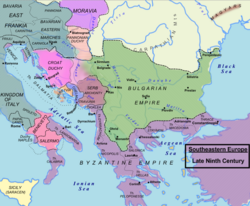
Back إمارة صربيا (العصور الوسطى الباكرة) Arabic Rascia AST Сръбско княжество Bulgarian Srbské knížectví (středověk) Czech Principado de Serbia (medieval) Spanish Serbia vürstkond (keskaegne) Estonian Principado de Serbia (medieval) Galician Kneževina Srbija (srednji vijek) Croatian Kepangeranan Serbia (abad pertengahan) ID Principato di Serbia (medievale) Italian
Principality of Serbia Кнежевина Србија Kneževina Srbija | |||||||||||||
|---|---|---|---|---|---|---|---|---|---|---|---|---|---|
| 780–960 | |||||||||||||
Emblem of
prince Strojimir | |||||||||||||
 Serbia during the rule of prince Vlastimir is shown in brown on this map of Southeastern Europe in 850. | |||||||||||||
| Capital | several cities Destinikon[1] | ||||||||||||
| Common languages | Old Serbian | ||||||||||||
| Religion | Slavic paganism (before 860s) Christianity (c. 870) | ||||||||||||
| Demonym(s) | Serbian, Serb | ||||||||||||
| Government | Monarchy | ||||||||||||
| Prince (Knyaz) | |||||||||||||
• c. 780 | Višeslav (first known by name) | ||||||||||||
• 831–850 | Vlastimir (notable) | ||||||||||||
• 850–891 | Mutimir (first Christian) | ||||||||||||
• 933–943/960 | Časlav (last) | ||||||||||||
| Historical era | Early Middle Ages | ||||||||||||
• Established | 780 | ||||||||||||
• Byzantine annexation | 960 | ||||||||||||
| ISO 3166 code | RS | ||||||||||||
| |||||||||||||
The Principality of Serbia (Serbian: Кнежевина Србија, romanized: Kneževina Srbija) was one of the early medieval states of the Serbs, located in the western regions of Southeastern Europe. It existed from the 8th century up to c. 969–971 and was ruled by the Vlastimirović dynasty. Its first ruler known by name was Višeslav who started ruling around 780. While by that time, starting from the year 680–681, the Bulgarian state had taken the lands to the east. Vlastimir resisted and defeated the Bulgarian army in a three-year-war (839–842), and the two powers lived in peace for some decades. Vlastimir's three sons succeeded in ruling Serbia together, although not for long; Serbia became a key part in the power struggle between the Byzantines and Bulgarians, predominantly allied with the Byzantines, which also resulted in major dynastic wars for a period of three decades. The principality was annexed in 924 by Simeon I and subjected to Bulgarian rule until 933 when Serbian prince Časlav was established as ruler of the Serbian land, becoming the most powerful ruler of the Vlastimirović dynasty.
An important process during this period was the Christianization of the Serbs,[2] completed by the establishment of Christianity as state-religion in the second half of the 9th century. The principality was annexed by the Byzantines in c. 969–971 and ruled as the Catepanate of Ras.[3] The main information of the history of the principality and Vlastimirović dynasty are recorded in the contemporary historical work De Administrando Imperio (written c. 948–949).[4][5][6]
- ^ Živković 2013a, pp. 47.
- ^ Špehar 2010, p. 203-220.
- ^ Krsmanović 2008, p. 135.
- ^ Moravcsik 1967.
- ^ Curta 2001, p. 64-66.
- ^ Živković 2010a, p. 117–131.
